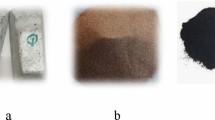Abstract
The aim of this study is to reveal how ZrO2 (zirconia) contributes to the machinability of aluminum 1050. In the first stage of this study, composite materials were produced by the vortex method by adding different amounts of ZrO2 (5%, 10%, 20%, and 30%) into commercial aluminum of 99.5% purity. Then, microstructure images of composite materials were taken under the scanning electron microscope (SEM), and the hardness of these composite materials was measured. In the last stage, the machinability tests of the composite materials were performed on the lathe under dry machining conditions at 125, 175, and 225 m/min cutting speeds and 0.03–0.06 and 0.12 mm/rev feed rates, with 1.5 mm constant depth of cut. Uncoated cementite carbide cutting tool inserts were used in machining tests. SEM images of the cutting tool inserts were taken, and the roughness values of the machined surfaces were measured. Chip samples were taken and investigated. It was observed that all the cutting tools had a Built-Up Edge (BUE) formation. Surface roughness and BUE formation increased as the feed rates were increased and decreased with increasing cutting speed. The roughness values decreased slightly and then increased again depending on the ZrO2 ratio. As the feed rates increased, a transition from ribbon chip type to the helical and saw-toothed forms was observed. It was also observed that the chip formation changed depending on the amount of ZrO2 in the composite structure.














Similar content being viewed by others
References
Zagórski I, Warda T (2018) Effect of technological parameters on the surface roughness of aluminium alloys after turning. Adv Sci Technol Res J 12(2):144–149. https://doi.org/10.12913/22998624/87136
Lin JT, Bhattacharyya D, Fergusod WG (1998) Chip formation in the machining of SiC-particle-reinforced aluminium-matrix composites. Compos Sci Technol 58:285–291. https://doi.org/10.1016/S0266-3538(97)00126-7
Liua R, Eatona E, Yua M, Kuanga J (2017) An investigation of side flow during chip formation in orthogonal cutting. Procedia Manuf 10:568–577. https://doi.org/10.1016/j.promfg.2017.07.053
Sasimurugan T, Palanikumar K (2011) Analysis of the machining characteristics on surface roughness of a hybrid aluminium metal matrix composite (Al6061–SiC–Al2O3). J Miner Mater Charact Eng 10(13):1213–1224. https://doi.org/10.4236/jmmce.2011.1013094
Nas E, Gökkaya H (2017) Experimental and statistical study on machinability of the composite materials with metal matrix Al/B4C/Graphite. Metall Mater Trans A 48A:5059–5067. https://doi.org/10.1007/s11661-017-4237-0
Anthony Xavior M, Ajith Kumar JP (2017) Machinability of hybrid metal matrix composite—a review. Proc Eng 174:1110–1118. https://doi.org/10.1016/j.proeng.2017.01.264
James JS, Annamalai AR (2018) Machinability study of developed composite AA6061-ZrO2 and analysis of influence of MQL. Metals 8(472):1–18. https://doi.org/10.3390/met8070472
Yadav RN, Mishra S, Yadav M (2017)A state of art on turning of metal matrix composites. ELK Asia Pac J 978-93-85537-06-6 ARIMPIE
Sekmen M, Günay M, Şeker U (2015) Effect on formations of built-up edge and built-up layer, surface roughness of cutting speed and rake angle in the machining of aluminum alloys. J Polytech 18(3):141–148. https://doi.org/10.2339/2015.18.3141-148
Mannaa A, Bhattacharayya B (2003) A study on machinability of Al/SiC-MMC. J Mater Process Technol 140:711–716. https://doi.org/10.1016/S0924-0136(03)00905-1
PramanikA Zhang LC, Arsecularatne JA (2007) An FEM investigation into the behavior of metal matrix composites:tool-particle interaction during orthogonal cutting. Int J Mach Tools Manuf 47:1497–1506. https://doi.org/10.1016/j.ijmachtools.2006.12.004
Radhika N, Subramanian R, Sajith A (2014) Analysis of chip formation in machining aluminium hybrid composites. E3 J Sci Res 2(1):009–015
Özcatalbaş Y (2003) Chip and built-up edge formation in the machining of in situ Al4C3–Al composite. Mater Des 24:215–221. https://doi.org/10.1016/S0261-3069(02)00146-2
Kamiya M, Yakou T, Sasaki T, Nagatsuma Y (2008) Effect of Si content on turning machinability of Al–Si binary alloy castings. Mater Trans 49(3):587–592. https://doi.org/10.2320/matertrans.L-MRA2007886
ISO 3685 (1993) Tool life testing with single-point turning tools. International Organization for Standardization, Case Postale 56l CH-1211, Geneve 20l, Switzerland
http://www.korloy.com/en/ebook/2016_2017%20KORLOY%20CUTTING%20TOOLS(EI)/assets/contents/download.pdf
Gomez L, Busquets-Mataix D, Amigo V, Salvador MD (2009) Analysis of boron carbide aluminium matrix composites. J Compos Mater 43:987–995. https://doi.org/10.1177/0021998308097731
Raviteja T, Radhika N, Raghu R (2008) Fabrication and mechanical properties of stir cast Al–Si12Cu/B4C composites. Int J Res Eng Technol 03(7):343–346. https://doi.org/10.15623/ijret.2014.0307058
Özben T, Kılıçkap E, Çakır O (2008) Investigation of mechanical and machinability properties of SiC particle reinforced Al-MMC. J Mater Process Technol 198:220–225. https://doi.org/10.1016/j.jmatprotec.2007.06.082
Satheesh J, Pasha T, Harish Madhusudhan T (2013) Optimal machining conditions for turning of AlSiC metal matrix composites using ANOVA. Int J Innov Res Sci Eng Technol 2(11):6171–6176
Gökkaya H, Nalbant M (2007) Investigating the effects of cutting speeds over the built-up layer and built-up edge formation with SEM. J Fac Eng Arch Gazi Univ 22(3):481–488
Xu D, Feng P, Li W, Ma Y, Liu B (2014) Research on chip formation parameters of aluminum alloy 6061-T6 based on high-speed orthogonal cutting model. Int J Adv Manuf Technol 72:955–962. https://doi.org/10.1007/s00170-014-5700-3
Vilches FJT, Hurtado LS, Fernández FM, Gamboa CB (2017) Analysis of the chip geometry in dry machining of aeronautical aluminum alloys. Appl Sci 7(132):1–13
Shetty R, Keni L, Pai R, Kamath V (2008) Experimental and analytical study on chip formation mechanism ın machining of DRACs. J Eng Appl Sci 3(5):27–32. https://doi.org/10.3390/app7020132
Basavarajappaa S, Davim JP (2013) Influence of graphite particles on surface roughness and chip formation studies in turning metal matrix composites. Mater Res 16(5):990–996. https://doi.org/10.1590/S1516-14392013005000098
Acknowledgements
This study was supported by Kirikkale University within the scope of the project numbered 2019/031.
Author information
Authors and Affiliations
Corresponding author
Additional information
Technical Editor: Jader Barbosa Jr., PhD.
Publisher's Note
Springer Nature remains neutral with regard to jurisdictional claims in published maps and institutional affiliations.
Rights and permissions
About this article
Cite this article
Pul, M. Investigation of the tool wear, surface roughness, and chip formation in the machining of ZrO2-reinforced aluminum composites. J Braz. Soc. Mech. Sci. Eng. 42, 565 (2020). https://doi.org/10.1007/s40430-020-02647-1
Received:
Accepted:
Published:
DOI: https://doi.org/10.1007/s40430-020-02647-1




